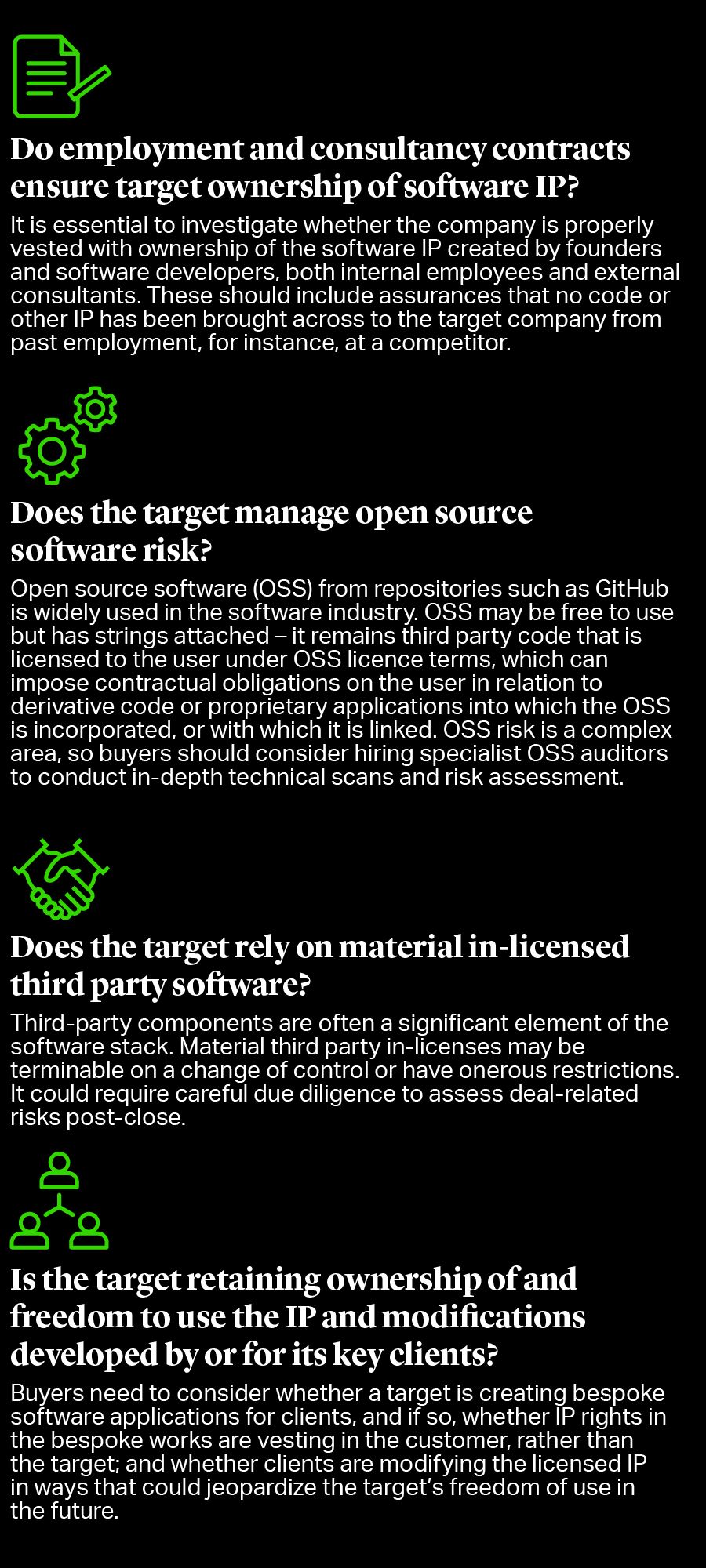Protecting
Value and Seizing
Opportunities
in Software Intellectual Property

Technology has become the largest sector for private equity investment as firms focus ever more on high-growth opportunities1. Within the technology space, software is the dominant sub-subsector, accounting for 90% – or $256bn – of investment value in 2021, according to Bain & Co., with public-to-private transactions for listed software groups representing a large portion of activity2.
Some firms are carving a large niche in the space. U.S. group Thoma Bravo is reported to have secured over $20bn for its fifteenth software-focused fund, which compares with some $1.25bn raised ten years ago for its tenth fund in 20123. European peer Hg is said to be targeting almost $15bn across a range of large-cap, mid-cap and small-cap funds, and has boosted its London-based team by almost a third in two years in response to increasing numbers of opportunities4. Multisector players like Blackstone, Bain Capital, KKR, and TPG have also each raised a $1 billion–plus fund aimed at technology and are increasingly looking to expand into earlier-stage growth equity investments5.
The rapid pace of development that makes software so dynamic also raises challenges for sponsors, particularly when it comes to identifying and protecting intellectual property (IP). Firms need to focus closely on target company rights during due diligence, move to remediate any issues pre-close, and find ways to enhance value during the ownership phase.


Identifying IP Risks
It can sometimes be challenging to obtain software patents in certain jurisdictions. Technical hurdles can be overcome but the patent requirement to disclose the underlying innovation may not be optimal in circumstances where the inner workings of a product are best kept secret or where the source code is in constant modification and evolution. This means that copyright protection is often better suited, since in many jurisdictions it arises automatically in original source code. However, even in jurisdictions where registering copyright is necessary or beneficial to evidence ownership, or stop others from copying it, software can evolve so rapidly that seeking to protect pieces of code may have little practical value. The result is that IP protection for a target company’s software platforms is largely invisible and has to be pieced together by investigating the contractual frameworks surrounding them, by asking questions such as:
Identifying IP Risks
It can sometimes be challenging to obtain software patents in certain jurisdictions. Technical hurdles can be overcome but the patent requirement to disclose the underlying innovation may not be optimal in circumstances where the inner workings of a product are best kept secret or where the source code is in constant modification and evolution. This means that copyright protection is often better suited, since in many jurisdictions it arises automatically in original source code. However, even in jurisdictions where registering copyright is necessary or beneficial to evidence ownership, or stop others from copying it, software can evolve so rapidly that seeking to protect pieces of code may have little practical value. The result is that IP protection for a target company’s software platforms is largely invisible and has to be pieced together by investigating the contractual frameworks surrounding them, by asking questions such as:

Remediating IP Risks During the Deal Process
The scope of software due diligence, including any technical OSS audits, is an important factor when obtaining coverage under Warranty & Indemnity (W&I) insurance. Where the risks identified can be remediated pre-close, buyers may seek to include covenants on sellers to do so – for instance, by implementing code fixes to mitigate or remove OSS or other third-party component dependencies.

Capturing Future Upside
The learnings from due diligence can be applied to enhance IP value during the ownership phase. Sponsors might review and revise company policies to ensure a more rigorous approach to scrutinizing and approving the introduction of any OSS or third-party elements. Similarly, customer contracts should be strengthened to protect and capture greater value from the company’s IP – for example, marginal drafting changes to the IP clauses in a target’s template client contract can result in exponential value capture when such template agreements are rolled out to key clients under long-term contracts under which IP accrues over significant periods of time.
The growth in private equity software investment owes much to the potential rewards on offer. Technology and software has become one of the most attractive sectors for returns, with 50% or more of deals generating at least 2.5x the private equity firms’ money, according to Bain & Co6. However, in-depth due diligence is vital to ensure that firms avoid potentially damaging software risks, while identifying ways to actively create value from IP.

United Kingdom
UK Core PE Group:
Extended Private Equity Practice:
Italy
Italian Core PE Group:
Extended Private Equity Practice:
France
French Core PE Group:
Extended Private Equity Practice:
Belgium
Belgian Core PE Group:
Extended Private Equity Practice:
Germany
German Core PE Group:
UAE






























